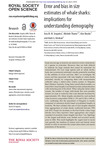Error and bias in size estimates of whale sharks: implications for understanding demography
| dc.contributor.author | Sequeira, Ana M. M. | en_US |
| dc.contributor.author | Thums, Michele | en_US |
| dc.contributor.author | Brooks, Kim | en_US |
| dc.date.accessioned | 2016-10-11T05:37:33Z | |
| dc.date.available | 2016-10-11T05:37:33Z | |
| dc.date.issued | 2016 | en_US |
| dc.identifier.other | HPU4160721 | en_US |
| dc.identifier.uri | https://lib.hpu.edu.vn/handle/123456789/23617 | en_US |
| dc.description.abstract | Body size and age at maturity are indicative of the vulnerability of a species to extinction. However, they are both difficult to estimate for large animals that cannot be restrained for measurement. For very large species such as whale sharks, body size is commonly estimated visually, potentially resulting in the addition of errors and bias. Here, we investigate the errors and bias associated with total lengths of whale sharks estimated visually by comparing them with measurements collected using a stereo-video camera system at Ningaloo Reef, Western Australia. | en_US |
| dc.format.extent | 12 p. | en_US |
| dc.format.mimetype | application/pdf | en_US |
| dc.language.iso | en | en_US |
| dc.subject | Biology | en_US |
| dc.subject | Ecology | en_US |
| dc.subject | Stereo-videomeasurements | en_US |
| dc.subject | Migratory species | en_US |
| dc.subject | Rhincodon typus | en_US |
| dc.subject | Maturity | en_US |
| dc.subject | Coastal aggregation | en_US |
| dc.subject | Conservation strategies | en_US |
| dc.title | Error and bias in size estimates of whale sharks: implications for understanding demography | en_US |
| dc.type | Article | en_US |
| dc.size | 593KB | en_US |
| dc.department | Education | en_US |
Files in this item
This item appears in the following Collection(s)
-
Education [806]

